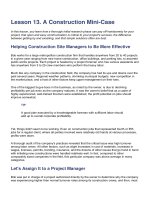MBA guide
Bạn đang xem bản rút gọn của tài liệu. Xem và tải ngay bản đầy đủ của tài liệu tại đây (3.64 MB, 114 trang )
MBAGuide
Specializationinbusinessmanagement
ManmohanJoshi
Downloadfreebooksat
Manmohan Joshi
MBA Guide
Specialization in business management
2
Download free eBooks at bookboon.com
MBA Guide: Specialization in business management
1st edition
© 2016 Manmohan Joshi & bookboon.com
ISBN 978-87-403-1196-9
3
Download free eBooks at bookboon.com
MBA Guide:
Specialization in business management
Contents
Contents
Preface
6
1
Business heory and Commercial Practice
7
2
Business Economics & Commerce
12
3
Management & Administration of People in Business
17
4
Advanced Management & Administration
23
5
Business Finance & Accounting
28
6
Sales & Marketing Administration
40
7
Human Resource/Personnel Management
46
www.sylvania.com
We do not reinvent
the wheel we reinvent
light.
Fascinating lighting offers an ininite spectrum of
possibilities: Innovative technologies and new
markets provide both opportunities and challenges.
An environment in which your expertise is in high
demand. Enjoy the supportive working atmosphere
within our global group and beneit from international
career paths. Implement sustainable ideas in close
cooperation with other specialists and contribute to
inluencing our future. Come and join us in reinventing
light every day.
Light is OSRAM
4
Download free eBooks at bookboon.com
Click on the ad to read more
MBA Guide:
Specialization in business management
Contents
8
Corporate Strategy & Planning
54
9
Managerial Economics
66
10
Business Finance & Investment
77
11
Management & Leadership
86
12
Marketing Strategy
97
Suggested Reading
113
About the Author
114
360°
thinking
.
Discover the truth at www.deloitte.ca/careers
5
Download free eBooks at bookboon.com
© Deloitte & Touche LLP and affiliated entities.
Click on the ad to read more
MBA Guide:
Specialization in business management
Preface
Preface
his guide contains sample questions and answers based on the MBA syllabus of various universities
and management institutes, particularly those in the UK.
Not all MBA aspirants join regular courses, particularly the working people. For them a lot of courses
are available through Distance Education or Online mode. hose who join these ind it a little diicult
to complete the various assignments that they have to complete, and sit examinations without having
an opportunity to learn how to write answers to questions posed during the examination.
he answers suggested in this Guide will enable the MBA aspirants to have an idea of the type of questions
and responses expected by reputed international universities and management institutes.
I take this opportunity to express my gratitude to Karin Hamilton Jakobsen, Sophie Tergeist and their
team at bookboon.com for publishing several of my books on various topics, including this one.
Manmohan Joshi
6
Download free eBooks at bookboon.com
MBA Guide:
Specialization in business management
Business Theory and Commercial Practice
1 Business Theory and
Commercial Practice
Question:
Explain the following:
i) Sole Proprietor;
ii) Responsibilities of Company Directors;
iii) Structure of business;
iv) Working Capital;
i) Market.
i)
Sole Proprietor:
he most common form of business ownership is the sole proprietorship, sometimes called the individual
proprietorship. his business is owned by one person. It is usually operated by the owner, possibly with
the help of family members or a few employees. Sole proprietorship can usually operate with very limited
capital (money) resources.
Advantages:
• his type of business is easy to set up.
• It is very lexible. he owner has the freedom to run the company how he/she likes.
• he proprietor can ofer a personal service.
• He/she can keep all the proits to himself/herself.
• Finances are kept private and accounting requirements are simple – the services of an
accountant may not be needed.
• he business can be changed to suit local needs.
Disadvantages:
• Ater normal trading hours, there still remains a lot of paperwork to be done, and only
one person to do it. One will need to work long hours to meet tight deadlines.
• It is more diicult to raise money to expand the business.
• If the owner is ill, he may have no cover to enable the business to carry on.
• It is risky. he owner is on his own, with no one to share the responsibilities of running
the business. He has unlimited liability.
7
Download free eBooks at bookboon.com
MBA Guide:
Specialization in business management
Business Theory and Commercial Practice
Examples of Sole Proprietorship:
• Small shop owner – fruit, vegetables, groceries
• Furniture shop owner
• Financial advisor
• Plumbing/electrical services
• Freelance journalist
he sole proprietor business is usually small though it is not always so. When the market conditions are
favourable and there is an increased demand for the products or services of a sole-proprietor’s business,
he/she may decide to expand the business. With expanding business the sole proprietor might decide to
change the business into a limited company. he reasons for doing so might be the following:
• he company has to be registered with the authorities of the country in which it has to operate.
hen it gets legal status and has the right to own property and perform other actions in its
own right. In this way it has a separate status and not linked to one person as is the case with
sole proprietor business. his helps the company to raise additional capital from banks and
other inancial institutions, which might have been diicult for the sole proprietor to do so.
• With expanding business the personal liability of the sole proprietor increases. he owner has
unlimited personal liability for the business debts, and he/she could lose all his/her possessions
to creditors. But once the sole proprietorship business is changed into a limited company, this
personal liability is limited. A person or organization buys shares in a limited company and
becomes a share-holder. In case the company does badly and fails, a share-holder’s responsibility
is limited to the amount of money invested in shares. hus he/she does not lose everything,
which might have happened if he/she had remained the sole proprietor.
• If a share-holder dies or retires, it does not afect the business of the company, as the company
continues to be run by professional management.
ii)
General responsibilities of company directors:
A limited company is governed by a Board of Directors who is elected by the share-holders to manage
the business on their behalf. he general responsibilities of these company directors are as follows:
• hey look ater the interests of share-holders, and ensure that the invested funds of shareholders are used in an efective way.
• hey are responsible for framing policies in order to achieve the objectives of the company.
hey are also responsible for the proper implementation of policies, and must be ready to make
the changes whenever it is necessary.
• hey must ensure the availability of working capital.
• hey are responsible for sanctioning capital expenditure towards purchase of machinery,
buildings and other infrastructure requirement.
8
Download free eBooks at bookboon.com
MBA Guide:
Specialization in business management
Business Theory and Commercial Practice
• hey are responsible for appointing personnel for top management positions.
• It is their responsibility to ensure efective management of the business, and to provide
leadership to the organization.
• hey are responsible to ensure that the business of the company is transacted as per legal
requirements of the country in which the company operates.
iii)
Structure of business:
he company directors and managers need to consider the following regarding the structure of their
business:
• It must be established as to which activities are necessary in order to achieve the objectives
of the business.
• he diferent activities should be organized into departments based on their functions, for
example, marketing, sales, production, inance, administration, human resource etc.
• In order to achieve efective functionality, these activities of various departments might be further
divided into sections, for example, sales may be divided into separate sections dealing with
diferent products, or area/region wise; HR department may have separate sections for recruitment
and general welfare and a separate section for training and development.
• It must be decided how many supervisors and middle-level managers are required for each
department, depending upon the volume and nature of business.
• It must be clearly decided as to what specialized knowledge and skills are required for
department/section managers.
• he limits of authority and duties of managerial positions must be clearly laid down. In addition,
there must be a provision for delegation of authority.
• Provision must be made for the layout of each section and department.
• Efective systems of communication – both vertical and horizontal – must be established in
order to ensure efective coordination among the various departments of the organization.
• An organization chart clearly deining the responsibilities and spans of control of various
positions must be decided upon, and made known to all.
9
Download free eBooks at bookboon.com
MBA Guide:
Specialization in business management
iv)
Business Theory and Commercial Practice
Working capital:
he working capital of an enterprise means the diference between the total value of an enterprise’s
current assets and the total value of its current liabilities. he availability of working capital is the most
important aspect of the business of an enterprise. he composition of an enterprise’s working capital
is very important. Some factors can change the composition of an enterprise’s working capital. Hence
company directors and managers must monitor any variations occurring in the following factors:
• Changes in the amount of production;
• Changes in the amount of sales;
• Changes in the levels of stocks;
• Changes in the purchase price;
• Changes in the sales price;
• Changes in credit terms for suppliers and customers;
• Changes in salary;
• Changes in exchange rates;
• Any other major expenditure.
he directors and managers must consider the working capital. hey must remember that:
• hey need to maintain business operations which are proitable; and
• Maintain a inancial position which ensures availability of funds to meet all the needs.
It is very important that an enterprise must be able to meet its debts when they are due for payment.
Sometimes there may be a situation which results in overtrading, and the business expands at such a
fast pace that it may not be possible to have enough working capital available to inance the expansion.
Hence directors and managers must always control the availability of suicient working capital.
v)
Market:
Company directors and managers need a market for selling their products or services. his means that
there are existing and potential customers who are willing to buy these products or services.
In some situations there is a ready market. For example, certain products which are available in large
cities are not available in small towns. However, the people in such small towns may be interested in
buying such products. In such a situation the management of an enterprise needs to make a market
survey to ind out the number of potential customers for its products, and whether the demand is for
one time only or it is likely to continue increasing. his will enable them to reach a decision whether to
start business in these towns.
10
Download free eBooks at bookboon.com









